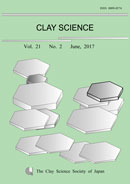
- Issue 4 Pages 63-
- Issue 3 Pages 41-
- Issue 2 Pages 21-
- Issue 1 Pages 1-
- |<
- <
- 1
- >
- >|
-
Natthawut (Beer) Homhuan, Kamonnart (Jaa) Imwiset, Thipwipa (Tip) Siri ...2017 Volume 21 Issue 2 Pages 21-28
Published: June 30, 2017
Released on J-STAGE: August 11, 2017
JOURNAL FREE ACCESSSince the first report on the magadiite and kenyaite minerals found in Kenya (1967), the preparation, characterization and uses of layered alkali silicates have been reported extensively. Ion exchange ability is one of the most important and useful characteristics of the layered alkali silicates, therefore, the ion exchange of layered alkali silicates with various inorganic, organic and organo-metallic cations have been investigated from the mineralogical, structural, chemical and application viewpoints. Among the layered alkali silicates, magadiite occupies the special position due to the ease of preparation and the structural stability and reactivity. In this review article, metal ion adsorption on magadiite was overviewed.
View full abstractDownload PDF (1146K)
-
Masaharu Nakagawa, K.V. Wilbert Kehelpannala, Takahiro Manabe, Lalindr ...2017 Volume 21 Issue 2 Pages 29-34
Published: June 30, 2017
Released on J-STAGE: August 11, 2017
JOURNAL FREE ACCESSHigh quality kaolin is mined at Meetiyagoda in southwestern Sri Lanka. The deposit occurs in a swampy area within the low-lying coastal region having a tropical wet climate. The kaolin clay beds form part of the Cenozoic fluvial sediments overlying the granulite and pegmatite of the Highland Complex formed by the late Neoproterozoic-Cambrian orogeny. The sedimentary clays are composed mainly of kaolinite and quartz. X-ray powder diffraction and scanning electron microscopy have revealed that kaolinite is well-crystallized variety and the platy crystals are not broken in the sedimentary clay. The sedimentary kaolin is considered to have been formed by intense tropical weathering of the aluminous granulite and pegmatite, and subsequently transported and deposited into low-lying swamps or marshes near the weathering crust over the basement rock. The kaolinite crystals might have undergone partial recrystallization in the swampy environment.
View full abstractDownload PDF (887K) -
Hidetaka Nanao, Hiroaki Amanuma, Kurumi Yoshida, Osamu Sato, Aritomo Y ...2017 Volume 21 Issue 2 Pages 35-39
Published: June 30, 2017
Released on J-STAGE: August 11, 2017
JOURNAL FREE ACCESSCatalytic activities of reference clays obtained from The Clay Society of Japan were studied for furfural production from xylose and bamboo powder in biphasic water and toleune solvents. JCSS-3101 and JCSS-3102, which are montmorillonite-type clays, were active for the furfural production in biphasic water and toluene solvents over 493 K.
View full abstractDownload PDF (511K)
- |<
- <
- 1
- >
- >|